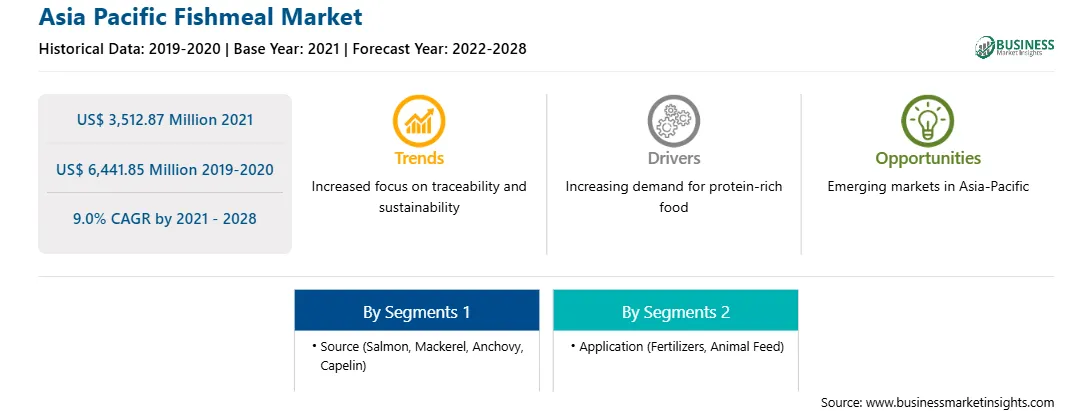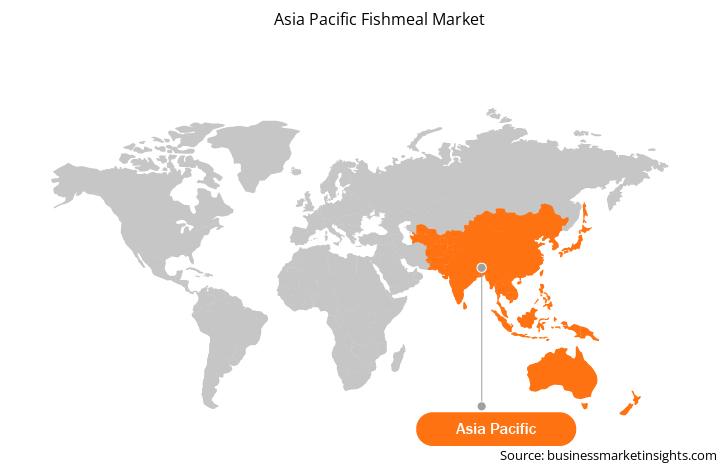Market Introduction
As per FAO data, APAC accounts for the highest production volume of aquaculture. The aquaculture industry in the region is focused on minimizing ecological impacts while maximizing investments. The growing middle class in the region is boosting demand for seafood, most of which is met by domestic production. India and China are among the highest-volume aquaculture producers in the region, and hence, they account for major shares in the fishmeal market in APAC. The governments of APAC countries are also supporting ambitious projects such as Yellow Sea salmonid farming project, worth US$ 143.9 million. Operator Wanzefeng Fishery aims to produce 20,000 tonnes of salmon yearly under the Yellow Sea project. Aquaculture highly relies on pursuing economic and nutritional objectives due to the vast coastal regions. Moreover, the growth of the food processing industry has led to an increased demand for fish products. The increasing aquaculture activities are expected to fuel the demand for fishmeal in the region.
Governments of various APAC countries are adopting possible steps to restrict the spread of the COVID-19 by announcing lockdown, which, in turn, has negatively impacted the revenue generated by the fishmeal market in this region.
Strategic insights for the Asia Pacific Fishmeal provides data-driven analysis of the industry landscape, including current trends, key players, and regional nuances. These insights offer actionable recommendations, enabling readers to differentiate themselves from competitors by identifying untapped segments or developing unique value propositions. Leveraging data analytics, these insights help industry players anticipate the market shifts, whether investors, manufacturers, or other stakeholders. A future-oriented perspective is essential, helping stakeholders anticipate market shifts and position themselves for long-term success in this dynamic region. Ultimately, effective strategic insights empower readers to make informed decisions that drive profitability and achieve their business objectives within the market. The geographic scope of the Asia Pacific Fishmeal refers to the specific areas in which a business operates and competes. Understanding local distinctions, such as diverse consumer preferences (e.g., demand for specific plug types or battery backup durations), varying economic conditions, and regulatory environments, is crucial for tailoring strategies to specific markets. Businesses can expand their reach by identifying underserved areas or adapting their offerings to meet local demands. A clear market focus allows for more effective resource allocation, targeted marketing campaigns, and better positioning against local competitors, ultimately driving growth in those targeted areas.Asia Pacific Fishmeal Strategic Insights

Asia Pacific Fishmeal Report Scope
Report Attribute
Details
Market size in 2021
US$ 3,512.87 Million
Market Size by 2028
US$ 6,441.85 Million
Global CAGR (2021 - 2028)
9.0%
Historical Data
2019-2020
Forecast period
2022-2028
Segments Covered
By Source
By Application
Regions and Countries Covered
Asia-Pacific
Market leaders and key company profiles
Asia Pacific Fishmeal Regional Insights

Market Overview and Dynamics
The fishmeal market in APAC is expected to grow from US$ 3,512.87 million in 2021 to US$ 6,441.85 million by 2028; it is estimated to grow at a CAGR of 9.0% from 2021 to 2028. As per a leading international animal feed manufacturer, the animal feed market in APAC is expected to grow at the highest pace during the forecast period. Moreover, the pet market is also soaring in the region due to high demand for cat food and dog food available in fish flavors. Animal feed and pet food contain fishmeal as a major ingredient to deliver required amino acids and omega fatty acids in the diet of animals. Therefore, the growth in animal feed market in the region is expected to propel the demand for fishmeal in the coming years.
Key Market Segments
APAC fishmeal market is segmented into source, application, and country. Based on source, the APAC fishmeal market is segmented into salmon, mackerel, anchovy, capelin, and others. In 2020, the anchovy segment accounted for the largest revenue share. Based on application, the APAC fishmeal market is segmented into animal feed, agriculture, and others. In 2020, the animal feed segment accounted for the largest revenue share. Based on country, the APAC fishmeal market is segmented into France, Germany, Italy, the UK, Russia, and rest of APAC. Rest of APAC held the largest market share in 2020.
Major Sources and Companies Listed
A few major primary and secondary sources referred to for preparing this report on the fishmeal market in APAC are company websites, annual reports, financial reports, national government documents, and statistical databases, among others. Major companies listed in the report are COPEINCA; Oceana Group Limited; Pelagia AS; Soytex LTD; TASA; and The Scoular Company.
Reasons to buy report
APAC
Fishmeal Market
Segmentation
APAC Fishmeal Market -
By Source
APAC Fishmeal Market - By
Application
APAC Fishmeal Market - By Country
APAC Fishmeal Market - Company Profiles
The Asia Pacific Fishmeal Market is valued at US$ 3,512.87 Million in 2021, it is projected to reach US$ 6,441.85 Million by 2028.
As per our report Asia Pacific Fishmeal Market, the market size is valued at US$ 3,512.87 Million in 2021, projecting it to reach US$ 6,441.85 Million by 2028. This translates to a CAGR of approximately 9.0% during the forecast period.
The Asia Pacific Fishmeal Market report typically cover these key segments-
The historic period, base year, and forecast period can vary slightly depending on the specific market research report. However, for the Asia Pacific Fishmeal Market report:
The Asia Pacific Fishmeal Market is populated by several key players, each contributing to its growth and innovation. Some of the major players include:
The Asia Pacific Fishmeal Market report is valuable for diverse stakeholders, including:
Essentially, anyone involved in or considering involvement in the Asia Pacific Fishmeal Market value chain can benefit from the information contained in a comprehensive market report.